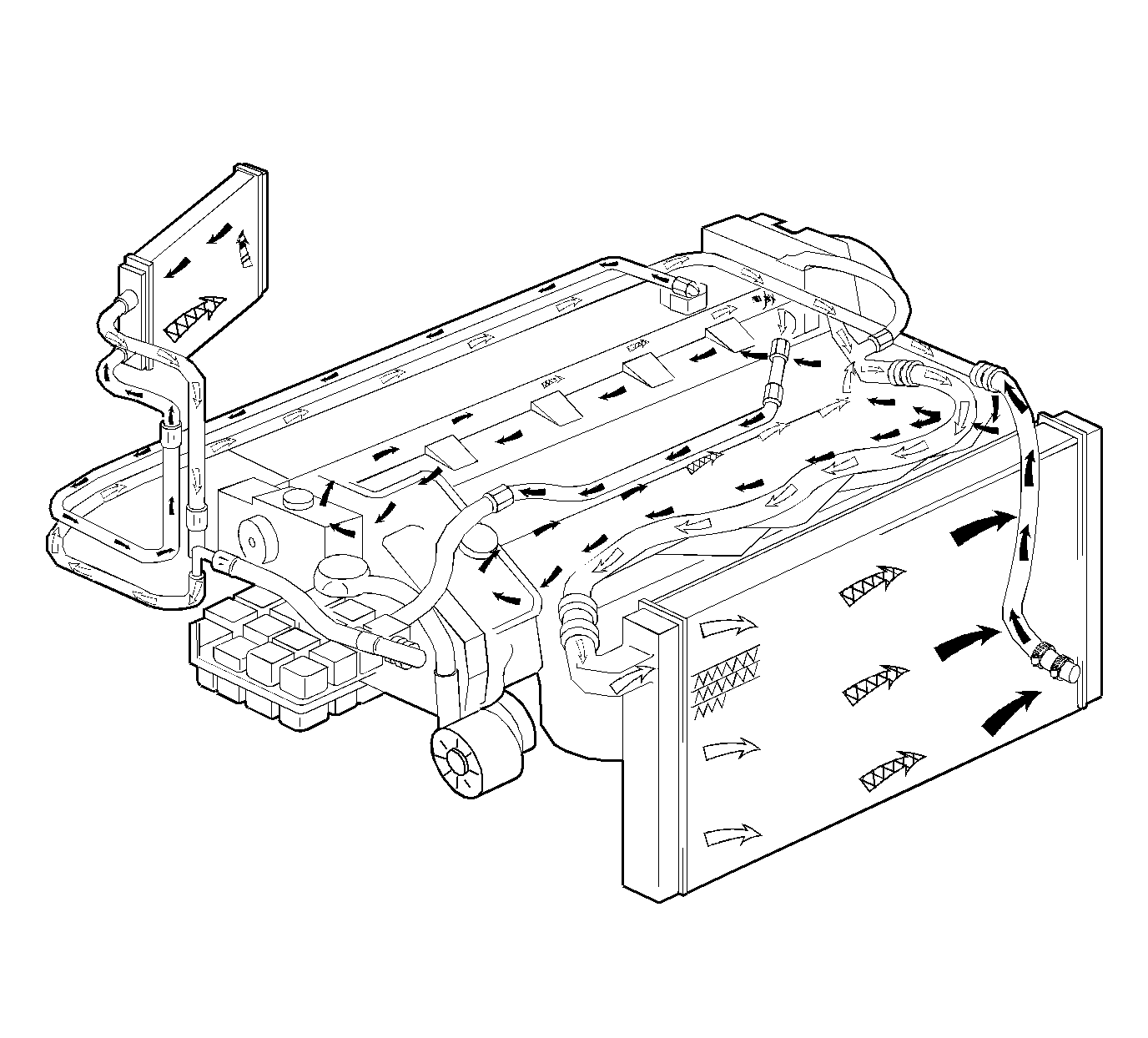General Description
The cooling system maintains proper engine temperature at an efficient
level under all operating conditions. When the engine is cold, coolant in
the radiator does not circulate, allowing for faster engine warm-up.
The thermostat remains closed until the engine reaches the proper operating
temperature. Once the engine reaches normal operating temperature, the thermostat
opens, and the coolant circulates through the crossflow radiator in order
to keep the engine from overheating.
The cooling system includes the following components:
| • | A radiator surge tank and pressure cap |
| • | 2 electric engine cooling fans |
| • | A thermostat and housing |
| • | A throttle body heater circuit |
Cooling System Circulation

| • | The dark arrow represents cold coolant flow. |
| • | The crosshatch arrow represents warm coolant flow. |
| • | The light arrow represents hot coolant flow. |
In the Northstar cooling system, the coolant pump takes coolant from
the radiator and passes the coolant through the thermostat on the inlet side
of the coolant pump. The coolant enters the block at the rear of the engine
from the water crossover, then the coolant is routed through the cylinder
heads back to the water crossover. At this point the coolant has four possible
routes:
| • | The throttle body heater circuit |
Engine Coolant
This vehicle has a newly developed engine coolant. GM Goodwrench DEX-COOL™
was developed to last for 166 000 km (100,000 mi) or
5 years, whichever occurs first. Follow the instructions in Draining/Filling
Cooling System. Make sure only GM Goodwrench DEX-COOL™ (orange-colored,
silicate-free) is used when coolant is added or changed.
A 50/50 mixture of ethylene glycol (GM Goodwrench DEX-COOL™) and
water will provide the following protection:
Notice: Pure coolant can be added to raise the boiling point of the coolant,
but too much will affect the freezing point. Do not use a solution stronger
than 70 percent, as the freeze level rises rapidly after this point.
Pure coolant will freeze at -22°C (-8°F).
| • | Give freezing protection down to -37°C (-34°F). |
| • | Give boiling protection up to 129°C (260°F). |
| • | Protect against rust and corrosion. |
| • | Help keep the proper engine temperature. |
| • | Let the warning lights and gauges work correctly. |
Throttle Body Coolant System
The throttle body coolant system uses pipes and hoses to divert coolant
to the throttle body. Coolant flows through the throttle body for cold weather
starts and helps provide a smooth idle until the engine reaches operating
temperature.
Radiator Air Baffle Assemblies, Deflectors, and Seals
A deflector redirects air flow. Deflectors are installed under the vehicle
and redirects the air flow beneath the vehicle to flow through the cooling
system and increase radiator cooling.
Air baffles are used to direct air into the radiator and
A/C condenser. Air seals ensure that air passes through, and does not bypass,
the radiator and the A/C condenser. A missing, damaged, or incorrectly installed
baffle or seal may cause the engine to overheat.
Radiator Surge Tank Pressure Cap

The surge tank uses a pressure-vent cap to allow a buildup of 103 kPa
(15 psi) in the cooling system. The cap allows the system to operate
at a higher-than-atmospheric pressure. This pressure raises the boiling point
of the coolant to about 125°C (262°F) at sea level.
The pressure-type cap contains a blowoff (pressure) valve (2) and a
vacuum (atmospheric) valve (1). The cap protects the radiator by relieving
any pressure that exceeds 103 kPa (15 psi).
In order to prevent radiator collapse, caused by vacuum as the engine
cools, the vacuum valve prevents excessive pressure differences from occurring
between the cooling system and the atmosphere.
The surge tank cap has a new threaded design to allow for easier and
safer removal. In order to safely remove the cap from a cool system, do the
following steps:
Caution: With a pressurized cooling system, the coolant temperature in the radiator
can be considerably higher than the boiling point of the solution at atmospheric
pressure. Removal of the surge tank cap, while the cooling system is hot and
under high pressure, causes the solution to boil instantaneously with explosive
force. This will cause the solution to spew out over the engine, the fenders,
and the person removing the cap. Serious bodily injury may result.
- Slowly rotate the cap counterclockwise ¼ turn and then stop,
do not press down.
- Allow any residual pressure, indicated by a hissing sound, to
be relieved.
- After the hissing stops, continue to rotate the cap counterclockwise
until the cap is removed.
There is no specific orientation of the lettering on the cap versus
the cap being tight. To retighten the cap, use hand tight pressure.


